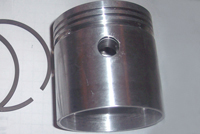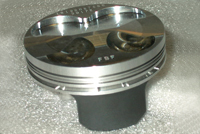An In-Depth Look at Piston Technology
December 4, 2008
By: Jason Giacchino
If you’re anything like us, the first thing that comes to mind when you think of innovations in today’s high performance four-stroke engines probably wont be the piston. However, to overlook the quintessential “beating heart” nestled within the cylinder bore would certainly be downplaying a major design development. In the event that you haven’t had a chance to study the piston in the top end of your quad recently, let us bring you up to speed on the process that turned a chunk of raw metal into a precision crafted power-provider.
Manufacturing
The stock piston in your ATV was made through a casting process rather than forging—squeeze casting to be exact. The process injects pressure to eliminate air bubbles that would otherwise be trapped within the molten metal. Although it should be noted that a cast piston, even one as well made as the stock OEM unit, pales in comparison to the forged pistons the factory racers cram into their engines. Don’t be surprised if an inexperienced mechanic tries to tell you that the stock piston was in fact forged; at a glance, they look very much alike.
The differences in both strength and tolerance lie deeper than the appearance however; in fact the raw material choices themselves play a major role in this. While cast pistons typically begin their life as a pool of molten 4032 aluminum that is poured into a cast to set, forged pistons are pressed under phenomenal pressure loads from aerospace 2618 aluminum stock. Naturally this results in lighter overall weights and increased durability.
So why even bother with casting in the first place when forged units boast higher tensile strength, better elasticity (in a very jarring environment), and longer fatigue life? Cost mostly. The theory of simple economics dictates that cost shavings in production can be passed down directly to the consumer. In other words there’s a reason factory quads cost tens of thousands on up while a competitive stocker will set you back around eight. Of course the beauty of the aftermarket means you can always upgrade to a forged unit at any time.
Size Matters
Forged pistons are slightly smaller than their cast counterparts. This is an intentional design feature which accounts for the fact that the forged piston will expand once the engine heats up to operating temperature. Upon startup, a forged piston will cause the engine to sound louder, or more rough. Finally, on account of the fact expansion more heavily affects forged pistons, they require additional ring gap as well.
From Buckets to Ashtrays
About the biggest difference between the modern four-stroke pistons from those of just a few short years ago takes only a passing glance to register: Gone are the long side-skirts in favor of a flat, shallow disk shape. So what happened that caused the long bucket shape of the piston to go the way of the dinosaur? To answer that, we have to first take a look back at the early days of the internal-combustion engine when suddenly the large flat disk-like pistons that drove steam engines were no longer necessary. The barrel shape, or “trunk piston” as it’s actually known, came about with its own wristpin and attached directly to the connecting rod. To combat the very legitimate concern of heat build-up, engineers were forced to increase the surface area of the piston itself. Dispersing the heat among a greater surface area was an effective means of keeping the piston lubricated and the lion’s share of the intense heat away from the top of the piston. Hence the long-skirt piston style was born and has remained in fashion since.
Old Piston:
*Note the long skirt, which adds friction, reducing power.
New Piston:
*Newer pistons have shorter skirts which reduce friction, increasing power.
We probably don’t need to get into as whole rhetoric to illustrate the simple reality that engines have made steady gains in performance since the onset of the internal combustion configuration. In fact today’s four-stroke mills put out massive gains compared even to equipment that was fairly fresh just a few years ago. Anyway, as engine RPM increases, so too does the inertia of the piston flying up and down within the cylinder and lo and behold, suddenly piston weight becomes a problem. How so you ask? More moving bulk not only increases the rate of wear but also pushes unnecessary fluid friction to areas such as the crank bearings.
As luck (or engineering destiny) would have it, engines became more performance oriented while innovations such as liquid cooling became practical. With much cooler cylinder walls thanks to circulating water, the intense friction heat of yesteryear was no longer near as problematic and hence less piston surface area became necessary to get the job done. Dispersing heat that was once the job of the piston’s surface area could now be accomplished through a thermostatically controlled, pressurized fluid circuit and like a rebellious school girl on her 18th birthday, the long skirt was the first thing to go.
Today’s much flatter pistons are the result of the harmony that exists within a modern engine; tasks that were once delegated to a single component are now divided among many. The piston may not have been your first answer to the question “how have modern four-strokes improved in recent years” but don’t assume that’s because they haven’t been evolving.
Manufacturer Links:
http://www.wiseco.com/Catalogs/ATV.aspx
http://www.jepistons.com/pdf/2006-moto3.pdf
